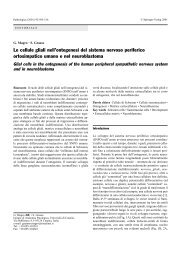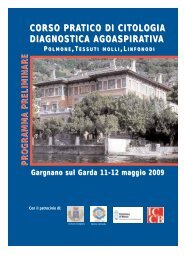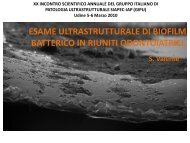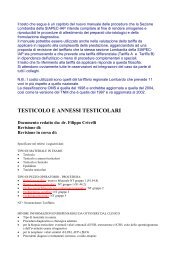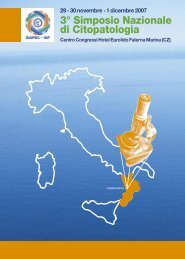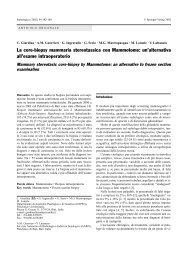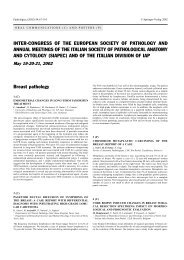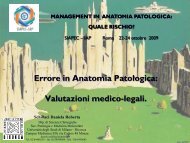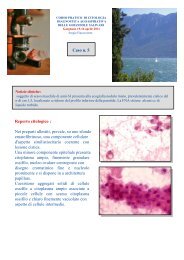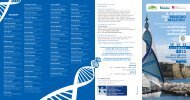Create successful ePaper yourself
Turn your PDF publications into a flip-book with our unique Google optimized e-Paper software.
312COMUNICAZIONI LIBEREcipitale di dx, il secondo di 13 aa con interessamento del lobofrontale ed il terzo di 22 aa con sede cerebellare. Alla risonanzamagnetica tali lesioni risultavano ben delimitate, cistiche,con enhancement del mezzo di contrasto. I pazienti sisono presentati all’osservazione clinica con segni neurologicisfumati.RisultatiMicroscopicamente la lesione si presentava moderatamentecellulata, con un pattern bifasico (aree microcistiche ed areecon architettura pseudopapillare). La componente cellulareera costituita da piccole cellule rotondeggianti intorno ad uncore stromale vascolare; nelle zone microcistiche, frammistealle piccole cellule, si osservano elementi di piccola e mediataglia, con nucleo vescicoloso, talora nucleolato. Si osservano,inoltre, aree più intensamente fibrillate, simil-pilocitichee con corti segmenti capillari.ConclusioniPGNT risulta essere quindi un’entità clinico-patologica attualmentenon inclusa nella classificazione WHO dei tumoridel Sistema Nervoso Centrale, caratterizzata da aspetti architetturalidistinti dalle varianti previste di tumore glioneuronaledi basso grado, con neurociti, cellule gangliari e celluleganglioidi e con prognosi favorevole. Come nel caso di altrelesioni del gruppo “neuronale-glioneuronale”, rimane da stabilirese questa entità sia da ritenersi su base amartomatosa odisembriogenetica, o se, al contrario, rappresenti una veraneoplasia.Bibliografia1Komori T, Scheithauer BW, Anthony D, Rosenblum MK, McLendonRE, Scott RM, Okazaki H, Kobayashi M. Papillary glioneuronal tumor.Am J Surg Pathol 1998;22(10):1171-83.2Prayson RA. Papillary Glioneuronal Tumor. Arch Pathol Lab Med2000;124(12):1820-3.On a case of anaplastic oligoastrocytomawith ependymal featuresE. Zunarelli, L. Reggiani Bonetti * , S. Bettelli * , L. Garagnani* , G.P. Trentini *Dipartimento Integrato di Servizi Diagnostici e di Laboratorioe di Medicina Legale, Anatomia Patologica, AziendaOspedaliera-Universitaria * , Policlinico di Modena, Modena,ItaliaIntroductionThe unusual morphology of a cerebral tumour with threecomponents, anaplastic oligoastrocytoma and ependymoma,is presented. These three components were distinctively appreciatedand intimately arised creating the tumour mass.Materials and methodsRoutine techniques, immunohistochemical methods and molecularanalysis were performed.Case study and resultsAn active, fit 70-year-old man collapsed suddenly, the clinicalpicture suggesting a stroke, after a 2-month history ofheadache.CT and MRI imaging disclosed a left frontal lobe lesion,rather superficial in location, 20 mm in maximum dimension,with a necrotic core in a well defined ring of contrast enhancementand peripheral oedema, most consistent with highgrade glioma.On gross examination, fragments of red-brownish soft tissue,4x3x1.7 cm in toto, were received. Histology showed a highgrade primitive glial tumour, hypercellular, mitotically active,necrotic, which affected mainly cortex and white matter. Thetumour had variegated tissue pattern, with apparently distinctcomponents, first anaplastic oligodendroglioma/astrocytoma(80-85%), and secondly anaplastic ependymoma (20-15%),with perivascular pseudorosettes which bore a definite resemblanceto those seen in ependymal tumours. The major oligodendroglialcomponent expressed GFAP, to a lesser extent S-100 protein; the ependymal-looking component was GFAPandS-100 negative. Synaptophysin yielded an aspecific positivityin both areas. EMA and MNF-116 were negative, as wellas melan-A. Proliferative activity (MIB-1 LI) was about 12%,p53 was focally expressed.FISH documented amplification of EGFR and polisomy ofchromosome 7 (aneuploid DNA). LOH for 1p 19q is currentlyundertaken.ConclusionsThe tumour was classified on the majority of the lesion,which was distinctly oligoastrocytomatous in nature; thenumber of mitotic figures and MIB-1 LI were sufficientlyhigh to allow a diagnosis of anaplastic oligoastrocytoma withependymal features. Mixed gliomas potentially represent themost likely to benefit from ancillary genetic characterization,both in morphological and prognostically meaningful terms.Molecular genetic alterations inoligodendroglial tumors: implications forpathological diagnosis and clinicalmanagementA. Arcella, M. Salvati * , M. Gessi, F. GiangasperoDept. of Experimental Medicine and Pathology, and * Dept.of Neurosurgery, University of Rome “La Sapienza”, IRCCSNeuromed, Pozzilli, ItalyIntroductionOligodendrogliomas and oligoastrocytomas in contrast to themajority of anaplastic astrocytomas and glioblastomas, frequentlyrespond favorably to chemotherapy. Oligodendroglialtumors are often associated with longer survival than diffuseastrocytic gliomas. These differences in response to therapyand in prognosis have been associated with distinct geneticaberrations, in particular, the frequent loss of heterozygosis(LOH) of alleles on chromosome arms 1p and 19q. In addition,other genetic changes (LOH 17p and 10q) have been reportedas indicators of poor response to therapy and short survival ingliomas. We examined 20 brain tumors for LOH on cromosome1p, 19q, 10q, and 17p, The LOH status was correlatedwith clinical behaviour and response to treatment.MethodsTwenty brain tumors, including 5 oligodendrogliomas (WHOII), 7 anaplastic oligodendrogliomas (WHO III), 2 oligoastrocytomas(WHO II), 1 anaplastic oligoastrocytomas (WHOIII), 2 glioblastomas (WHO IV), 1 anaplastic astrocytomas(WHO III), 1 pleomorphic xanthoastrocytoma (PXA) (WHOII) and 1 ganglioglioma (WHO I). Tumor DNA was extractedfrom paraffin-embedded sections; constitutional DNA wasextracted from blood lymphocytes. Allelic chromosomal losswas assessed by loss of heterozygosity assays in constitutionalDNA/tumor DNA pairs using microsatellite markerson 1p36.3, 1p32, 1p13 (D1S508; D1S2743; D1S457),19q13.3 (D19S219, D19S412), 10q22 (D10S562), 10q26(D10S212), 17p13 (D17S1353) and 17p12 (D17S520).





